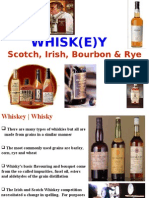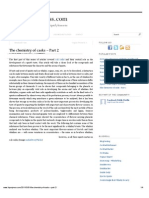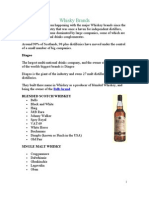Whisky
Whisky
Uploaded by
Saheb MantriCopyright:
Available Formats
Whisky
Whisky
Uploaded by
Saheb MantriCopyright
Available Formats
Share this document
Did you find this document useful?
Is this content inappropriate?
Copyright:
Available Formats
Whisky
Whisky
Uploaded by
Saheb MantriCopyright:
Available Formats
by SAHEB MANTRI
Making whisky Types of whisky
Malt whisky Pot still whisky Grain whisky Blended whisky Straight whisky Scotch whisky (Scotch) Irish whiskey Kentucky whiskey (Bourbon) Tennessee Whisky Canadian whisky
Whisky by location
Fermenting
The dried malt (or other grains) is ground and soaked in water, dissolving the sugar and producing wort Yeast is then added, and the wort is allowed to ferment, producing wash or low beer. Pot still Coffey or patent still
Distilling
Heat is applied directly to the pot containing the mash Alcohol, water and flavor components evaporate
The vapor is richer in alcohol than the liquid Condensing this vapor results in a higher alcohol liquid
The first distillation produces so-called 'low wines', (25-35% abv) The second distillation produces the colourless spirit, collected at about (70% abv)
Also called a column still, continuous still or Coffey still Consists of two columns
The rectifier, has steam rising and wash descending The analyzer carries the alcohol from the wash where it circulates until it can condense
Like a series of single pot stills, in a long vertical tube.
The tube is filled with porous packing or bubble plates, creating levels in the tube The rising vapor starts to condense in the cooler, higher level of the column. The temperature of each successively higher stage is slightly lower than the previous stage, and so the vapor in equilibrium with the liquid at each stage is progressively more enriched in alcohol. Can achieve a vapor alcohol content of 96%.
Aging
In new (for Bourbon) or old, charred (Bourbon & Scotch) or uncharred (Irish Whiskey) oak barrels/casks Typically causes the brown color to develop over time 0.5 2.0% volume evaporates each year of aging (making long-aged whiskies more expensive to produce) Mature whisky is usually blended Water is usually added (to reduce alcohol content) Whisky is chilled to near 0C (32F) and passed through a fine filter Removes some of the compounds accumulated during distillation or aging, prevents the whisky from becoming hazy when chilled Can also remove some of the flavor and body from the whisky
Bottling
Chill Filtration
Malting: A process applied to cereal grains, in which the grains are made to germinate and then quickly dried before the plant develops. Malt whisky from one distillery is called single malt Generally distilled in a pot still
Made
from a combination of malted and unmalted barley (thus differing from single malt whiskey) General ratio is about 60:40 (unmalted:malted) Distilled in a pot still
Applies to whiskeys made from rye, corn, wheat, unmalted barley Produced in a patent still by a continuous process. Less flavour than malt whisky Is generally less popular, therefore seldom bottled and hard to find An important component of most Scotch Whisky Often blended with malt whisky to produce a blended whisky
Drawn from whiskies of differing vintages and/or manufacturers A blend of either single malt or straight whiskey together with grain whisky
The malt or straight whisky used is normally identified on the label The best blended whiskies contain the most malt whisky, or are entirely made from malt whiskies
Less expensive to produce than other types of whisky Most popular whiskies served bars are blended whiskeys Most mixed drinks that call for whisky use blended whisky
Straight whiskies must be made with a minimum of 51% of the grain that identifies that particular whiskey.
Rye Wheat Corn Unmalted barley
Straight whiskey must be aged a minimum of 2 years.
Distilled at a Scottish distillery from water and malted barley Only other whole grains may be added Must have an alcoholic strength of less than 94.8% by volume Must be matured in Scotland in charred oak casks for at least three years (giving it smoky & earthy overtones) Most single malts are aged for at least 8 years Must not contain any added substance other than water and caramel colour Typically distilled twice
Similar to Scotch whisky in ingredients & production Typically distilled 3 times Aged in uncharred barrels (unlike Scotch or Bourbon) Pure pot still whiskey is uniquely Irish Only 3 distilleries remain in Ireland:
Bushmills Midleton Cooley
American Whiskey (e.g. Jim Beam)
all but a few distilleries are in Kentucky
At least 51% corn or maize (typically about 70%)
The remainder is wheat, rye, and malted barley
Distilled to no more than 160 (U.S.) proof Must be put into the barrels at no more than 125 U.S. proof Aged in new (unlike Scotch) charred white oak barrels for at least two years, maybe longer. After aging, is generally adjusted to 80100 proof and bottled, although some are bottled at cask strength.
The whiskey is filtered through an approximately 10 foot thick layer of maple charcoal (the Lincoln County Process) Gives the whiskey a distinctive flavor Makes it unusually mild Jack Daniels
Must
be barrel aged at least three years Most are blended multi-grain whiskies Traditionally called rye whisky," they contain proprietary blends of corn, barley, and rye. Seagrams
You might also like
- Science and Engineering of Chinese Liquor (Baijiu) Microbiology, Chemistry and Process Technology (Yan Xu) - English - Springer - 2023 (Z-Library)Document614 pagesScience and Engineering of Chinese Liquor (Baijiu) Microbiology, Chemistry and Process Technology (Yan Xu) - English - Springer - 2023 (Z-Library)eletrolivrariaNo ratings yet
- Industrial Hotel Training ReportDocument129 pagesIndustrial Hotel Training ReportSaheb Mantri93% (15)
- Zymurgy Bob's Making The CutsDocument2 pagesZymurgy Bob's Making The CutsTy Fitwilly100% (1)
- Whisky 101 PresentationDocument55 pagesWhisky 101 PresentationGerald De Los SantosNo ratings yet
- Whisky Speaking NotesDocument7 pagesWhisky Speaking NotesBaldpacker (Baldpacker)No ratings yet
- Guayakí Impact Report 2020 ENGLISHDocument12 pagesGuayakí Impact Report 2020 ENGLISHLucas figueroaNo ratings yet
- E - WhiskeyDocument22 pagesE - Whiskeylorenz777No ratings yet
- Recipes for Brewing Different Types of Beers and AlesFrom EverandRecipes for Brewing Different Types of Beers and AlesNo ratings yet
- Maza Gomez ThesisDocument154 pagesMaza Gomez ThesisSulaiman Salihu100% (1)
- Alcoholic Beverages: by Vikash PrasadDocument8 pagesAlcoholic Beverages: by Vikash PrasadRo NyNo ratings yet
- Chapter 4 - Microbiology and BiotechnologyDocument64 pagesChapter 4 - Microbiology and BiotechnologyLazarus Kadett NdivayeleNo ratings yet
- Liqueur by Abhilash SirDocument10 pagesLiqueur by Abhilash SirSanika AgrawalNo ratings yet
- Peat Phenol PPMDocument4 pagesPeat Phenol PPMdragan100% (1)
- Distillation of GinDocument6 pagesDistillation of GinJan Chester ChanNo ratings yet
- How Are Spirits MadeDocument10 pagesHow Are Spirits MadesmsNo ratings yet
- Fermentation PathwaysDocument5 pagesFermentation PathwaysNurcahyaniNo ratings yet
- Processes For Alcohol-Free Beer Production A ReviewDocument9 pagesProcesses For Alcohol-Free Beer Production A Reviewzapleirbag100% (1)
- Brew Hoppy Wheat Beer Like A MonkDocument32 pagesBrew Hoppy Wheat Beer Like A Monkdiego jesusNo ratings yet
- Sherry PDFDocument3 pagesSherry PDFWill KeyNo ratings yet
- Beer IndustryDocument23 pagesBeer IndustrySonit PaulNo ratings yet
- Aperitif & DigestifDocument31 pagesAperitif & DigestifMihir HareetNo ratings yet
- Wikipedia Belgian Beer PDFDocument52 pagesWikipedia Belgian Beer PDFbartekguzikNo ratings yet
- 2010 SOQ 3 Belgian StrongDocument5 pages2010 SOQ 3 Belgian StrongJoao Carlos MaximianoNo ratings yet
- Distilling ParrotDocument18 pagesDistilling Parrotapi-1821010100% (2)
- Distilled Spirits: II. Distilled Spirits - Types of Alcoholic Beverages Made by Distilling Fermented Beverages Made FromDocument10 pagesDistilled Spirits: II. Distilled Spirits - Types of Alcoholic Beverages Made by Distilling Fermented Beverages Made FromVeverley CarupoNo ratings yet
- Distillery ProcessDocument1 pageDistillery ProcessNagaraja Reddy Rasi ReddyNo ratings yet
- Tequila - The Spirit of MexicoDocument47 pagesTequila - The Spirit of MexicoSabuj JanaNo ratings yet
- Carbonation TablesDocument6 pagesCarbonation TablesVohinh NgoNo ratings yet
- Gin - VODKA - Vodka Is A Neutral Spirit Made From The Fermentation and TEQUILA - Tequila Is Fermented & Distilled Alcoholic Beverage Made From TheDocument20 pagesGin - VODKA - Vodka Is A Neutral Spirit Made From The Fermentation and TEQUILA - Tequila Is Fermented & Distilled Alcoholic Beverage Made From TheHARSHITNo ratings yet
- Gin Act DBQDocument3 pagesGin Act DBQMichael Liu50% (2)
- WINES and SPIRITSDocument3 pagesWINES and SPIRITSCelina PastorNo ratings yet
- Is 5286Document6 pagesIs 5286crazyprajNo ratings yet
- Guayaki Global Impact ReportDocument10 pagesGuayaki Global Impact ReportHugo CámaraNo ratings yet
- Determination of Ethanol Content From Ginebra Gin by Fractional DistillationDocument4 pagesDetermination of Ethanol Content From Ginebra Gin by Fractional DistillationToni Sy EncinaresNo ratings yet
- Beer Tending Mix OlogyDocument22 pagesBeer Tending Mix OlogynormaNo ratings yet
- Whisky Shop Top Secret Fact FileDocument7 pagesWhisky Shop Top Secret Fact FileDonald Ducky Win100% (1)
- Swa Tasting Toolkit - 2020Document13 pagesSwa Tasting Toolkit - 2020Long100% (1)
- Herbs Spices and Condiments-1Document5 pagesHerbs Spices and Condiments-1kavayareagan254No ratings yet
- Making Malt WhiskyDocument1 pageMaking Malt WhiskywhybotheridkNo ratings yet
- Cat's Meow Home Brewing 08 Fruit BeerDocument26 pagesCat's Meow Home Brewing 08 Fruit BeernawickNo ratings yet
- Scotch Whisky Produced in The Highlands RegionDocument2 pagesScotch Whisky Produced in The Highlands Regionwhisky-exchangeNo ratings yet
- Distillation - The Science of DistillationDocument3 pagesDistillation - The Science of DistillationFoo Cheok HwaNo ratings yet
- Brandy (1679)Document10 pagesBrandy (1679)Hunter KiranNo ratings yet
- Whisky Distilleries Guides Lowland PDFDocument9 pagesWhisky Distilleries Guides Lowland PDFAttila AygininNo ratings yet
- How To Conduct A Successful and Fun Beer Tasting Event: by Peter L. CherpackDocument14 pagesHow To Conduct A Successful and Fun Beer Tasting Event: by Peter L. CherpackRoberto Asencion AlcantarNo ratings yet
- Beer ConditioningDocument53 pagesBeer ConditioningMithraNo ratings yet
- Rule #1: Determine Proper TemperatureDocument3 pagesRule #1: Determine Proper TemperatureUtkarsh MathurNo ratings yet
- WhiskyBox Tasting Notes v2Document41 pagesWhiskyBox Tasting Notes v2jpNo ratings yet
- Bar LicenseDocument13 pagesBar LicenseOnkar SharmaNo ratings yet
- Cat's Meow Home Brewing 05 Stout PorterDocument48 pagesCat's Meow Home Brewing 05 Stout PorternawickNo ratings yet
- The Chemistry of Casks - Part 2 - Production - Bourbon, Chemistry, Cognac, Oak Maturation, Rum, Whiskey, WhiskyDocument4 pagesThe Chemistry of Casks - Part 2 - Production - Bourbon, Chemistry, Cognac, Oak Maturation, Rum, Whiskey, WhiskyRachel HechanovaNo ratings yet
- Distillation 123Document12 pagesDistillation 123Mukesh TiwariNo ratings yet
- Brandy & It'S ProcessingDocument71 pagesBrandy & It'S Processingrubike rubikeNo ratings yet
- Ref PlanDocument4 pagesRef Planアルビン ベネNo ratings yet
- Bourbon: Corny, Delectable and A Toast To The French.Document3 pagesBourbon: Corny, Delectable and A Toast To The French.Brainwines.comNo ratings yet
- Equivalencia FermentosDocument1 pageEquivalencia FermentosBruno QuintaoNo ratings yet
- YeastStarter PDFDocument6 pagesYeastStarter PDFHiran GonçalvesNo ratings yet
- Homebrewing Sake - Nelson CrowleDocument5 pagesHomebrewing Sake - Nelson CrowlerusoexpressNo ratings yet
- Whisky BrandsDocument18 pagesWhisky BrandsGaurang RaneNo ratings yet
- Beer Brewing Recipes: American Lite Lager EditionFrom EverandBeer Brewing Recipes: American Lite Lager EditionRating: 2 out of 5 stars2/5 (1)
- Custid: (3days & 2 Night)Document3 pagesCustid: (3days & 2 Night)Saheb MantriNo ratings yet
- Rice Which Is Flattened Into Flat Light Dry Flakes: Puris FlourDocument5 pagesRice Which Is Flattened Into Flat Light Dry Flakes: Puris FlourSaheb MantriNo ratings yet
- Spice & HerbDocument68 pagesSpice & HerbSaheb MantriNo ratings yet
- Salad: Sandwich & BurgarDocument2 pagesSalad: Sandwich & BurgarSaheb MantriNo ratings yet
- Saheb Mantri: Curriculum VitaeDocument3 pagesSaheb Mantri: Curriculum VitaeSaheb MantriNo ratings yet
- Housekeeping TerminologyDocument3 pagesHousekeeping TerminologySaheb MantriNo ratings yet


































































